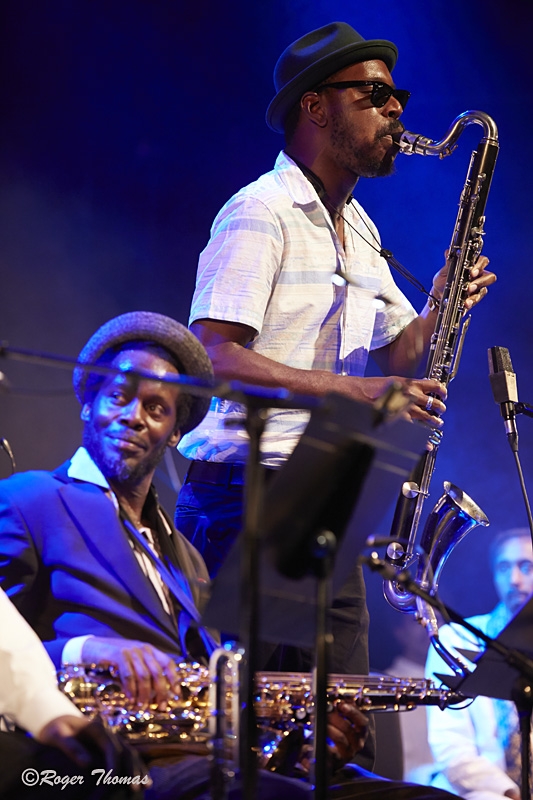Preview: John Coltrane's A Love Supreme | reviews, news & interviews
Preview: John Coltrane's A Love Supreme
Preview: John Coltrane's A Love Supreme
Unique fusion of spiritual and musical inspiration 're-envisioned' for 50th anniversary performance
John Coltrane’s album A Love Supreme, recorded 50 years ago next week, is second only to Miles Davis' Kind of Blue as a revered document of jazz recording.
The spiritual intensity of Coltrane’s tone, and the aspects of the prodigious technical accomplishments of the final years of his life, are what make the album so remarkable and enduring. Coltrane’s technical innovations include the sixteenth-note phrases which enabled him to explore large numbers of chord progressions in a solo, and the exploration of modes and scales as an alternative to the chord progressions of traditional jazz.
Coltrane was a gentle, humble man in his personal life, yet Miles Davis (in whose quintet he played for many years, including on Kind of Blue) said, “You have to remember, Coltrane was a very greedy man.” He wasn’t, it’s assumed, suggesting Coltrane was a hog at the tour motel buffet, or even alluding uncharitably to his various addictions (which contributed to a tragically early death), but was probably describing his appetite for creative and intellectual novelty, which was ravenous.

As a tribute to and celebration of this extraordinary event, flautist and composer Rowland Sutherland has arranged Coltrane’s work for his 15-piece Enlightenment Orchestra. With singer Cleveland Watkiss, saxophonists Steve Williamson (pictured) and Shabaka Hutchings, and pianist Pat Thomas, directed by Orphy Robinson from the xylosynth, the band has some of the most experienced players on the avant-garde jazz scene. Intriguingly, and apparently in an attempt to draw out the piece’s spiritual and world music inspiration (Coltrane drew broadly on Indian and West African spirituality), Sutherland has included parts for kora, tablas and bata drums, which aren’t in Coltrane’s quartet version. The direct referencing of Coltrane’s non-Western sources in this way could be brilliant or clumsy, but when the starting point is a piece so inspired, the performance will fascinate, at the very least, and has the potential to be a monumental event.
- A Re-Envisioning of John Coltrane’s A Love Supreme takes place on 9 December at Union Chapel
- Next page: listen to Coltrane's A Love Supreme on YouTube
The future of Arts Journalism
You can stop theartsdesk.com closing!
We urgently need financing to survive. Our fundraising drive has thus far raised £49,000 but we need to reach £100,000 or we will be forced to close. Please contribute here: https://gofund.me/c3f6033d
And if you can forward this information to anyone who might assist, we’d be grateful.

Subscribe to theartsdesk.com
Thank you for continuing to read our work on theartsdesk.com. For unlimited access to every article in its entirety, including our archive of more than 15,000 pieces, we're asking for £5 per month or £40 per year. We feel it's a very good deal, and hope you do too.
To take a subscription now simply click here.
And if you're looking for that extra gift for a friend or family member, why not treat them to a theartsdesk.com gift subscription?
more New music
 Album: Eve Adams - American Dust
Taking inspiration from the Californian desert
Album: Eve Adams - American Dust
Taking inspiration from the Californian desert
 Gibby Haynes, O2 Academy 2, Birmingham review - ex-Butthole Surfer goes School of Rock
Butthole Surfers’ frontman is still flying his freak flag but in a slightly more restrained manner
Gibby Haynes, O2 Academy 2, Birmingham review - ex-Butthole Surfer goes School of Rock
Butthole Surfers’ frontman is still flying his freak flag but in a slightly more restrained manner
 Album: Adrian Sherwood - The Collapse of Everything
The dub maestro stretches out and chills
Album: Adrian Sherwood - The Collapse of Everything
The dub maestro stretches out and chills
 Music Reissues Weekly: The Residents - American Composer's Series
James Brown, George Gershwin, John Philip Sousa and Hank Williams as seen through an eyeball-headed lens
Music Reissues Weekly: The Residents - American Composer's Series
James Brown, George Gershwin, John Philip Sousa and Hank Williams as seen through an eyeball-headed lens
 Album: Dinosaur Pile-Up - I've Felt Better
Heavy rock power pop trio return after an unwanted lengthy break
Album: Dinosaur Pile-Up - I've Felt Better
Heavy rock power pop trio return after an unwanted lengthy break
 Album: Tom Grennan - Everywhere I Went Led Me To Where I Didn't Want To Be
British pop star's fourth exhibits ultra-pop oomph with mixed results
Album: Tom Grennan - Everywhere I Went Led Me To Where I Didn't Want To Be
British pop star's fourth exhibits ultra-pop oomph with mixed results
 Album: Emma Smith - Bitter Orange
The award-winning jazz singer brings new life to some classic standards
Album: Emma Smith - Bitter Orange
The award-winning jazz singer brings new life to some classic standards
 BBC Proms: Anoushka Shankar 'Chapters' review - somehow, it worked
Shankar's starry presence brings focus to this orchestral version
BBC Proms: Anoushka Shankar 'Chapters' review - somehow, it worked
Shankar's starry presence brings focus to this orchestral version
 Album: Marissa Nadler - New Radiations
The Nashville-based singer-songwriter explores disconnection
Album: Marissa Nadler - New Radiations
The Nashville-based singer-songwriter explores disconnection
 Album: Rise Against - Ricochet
Have the US punk veterans finally run out of road?
Album: Rise Against - Ricochet
Have the US punk veterans finally run out of road?
 Music Reissues Weekly: The Final Solution - Just Like Gold
Despite their idiotic name, these San Francisco psychedelic pioneers sounded astonishing
Music Reissues Weekly: The Final Solution - Just Like Gold
Despite their idiotic name, these San Francisco psychedelic pioneers sounded astonishing
 Mogwai / Lankum, South Facing Festival review - rich atmospheres in a south London field
Two polished performances and an embarrassment of instruments
Mogwai / Lankum, South Facing Festival review - rich atmospheres in a south London field
Two polished performances and an embarrassment of instruments

Add comment